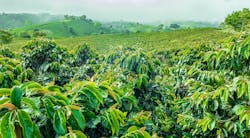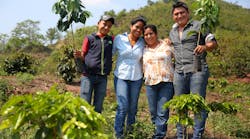Those who deal in coffee are used to volatility. Historically it’s been a boom-bust business, explains Marc Schonland, vice president coffee strategy at Royal Cup Coffee and a board member of the World Coffee Research. It cycles through periods of low prices that lead to production falling until a tipping point is reached where a deficit is anticipated — causing prices to shoot up again. This in turn stimulates new and incremental production in response to the high prices that leads again to a surplus, and prices come crashing down again. Plus, many factors affect coffee production, from weather patterns to local economics. “Our supply chain is extremely fragile,” Schonland said, which is why experts in the field are trying to educate people about the coffee price crisis. Continuing as we are can lead not only to ongoing cycles of boom and bust periods but will eventually force many producers out of coffee permanently leaving us with only low-grade coffee as the only option as quality coffee growers abandon farms, says Schonland.
Coffee sells for less than it costs
There is an abundance of coffee coming from Brazil, Schonland explains. Like with other surpluses, this has driven the price of coffee under a dollar a pound, which he says is far below the cost of production. Coffee growers live a level or two above poverty, so low priced markets mean coffee producers don’t have money to spend on nutrients and fertilizers to feed the coffee trees, resulting in the trees producing less.
“When prices go down, coffee farmers don’t have savings to go to,” Schonland said. “Instead they do what rational people do, they put less input and less energy into their coffee production. As a result, the crops start to produce less and less.” “This slow erosion of production, takes place against the inexorable rise in global demand: and when those supply and demand lines appear to be crossing; price suddenly — and sometimes violently — reacts to ration demand.”
Prices sub a dollar per pound drive these farmers to abandon coffee trees or plant other crops. It can also cause some farmers to completely abandon farms, trying to illegally immigrate to other countries, such as the U.S., for a better livelihood and a more secure source of income.
Global economics
We haven’t yet felt the decrease in coffee production that comes when prices are too low mostly due to booming production in Brazil and to some extent Vietnam. The two largest producers on the globe by quantity if not quality. Many farmers are still able to hang on to coffee plantations for now because their local currency, compared to the U.S. dollar, makes the low price nearly sustainable since they export in U.S. dollars.
“The economics are different country to country,” said Schonland. “In, Brazil, for example, a farmer may be getting 400 Brazilian reals per bag of coffee.” While the ideal price might be more like 500, because the ratio of reals to U.S. dollars is now nearly 4 to 1, instead of the 2 to 1 of 5 years ago, that farmer is surviving, but it won’t last long term, Schonland warns.
“Weak local currencies offset some of these dollar price decreases, but by and large production costs are now higher than what growers are receiving,” Schonland said. “We are in a position where production is going to go down and down, and eventually when the pain gets to be too much, and supply is no longer forthcoming, price is going to skyrocket.”
There are some coffee growers who welcome the time when prices will be at record highs. The benefit will be short-lived; however, as it will encourage production again, leading to more farmers, growing more coffee. It will take 2 to 3 years before the market has enough supply to meet demand, but eventually there will be a surplus that will drive down prices, again.
Outcome: extinction of high-quality
Even more undesirable than the continuation of the boom-bust cycle is the risk of losing really good coffee. If nothing changes in the coffee market, Schonland foresees one of several scenarios happening. The worst is that the world will lose coffee from great coffee producing countries. This is the reason people like him are talking about a coffee supply and price crisis.
“We will lose the diversity of coffee,” Schonland said, “the great, classical high-quality production countries — Colombia, Guatemala, Kenya. We might lose their production because the market will become dominated by low quality volume producers like Brazil and Vietnam.”
Brazil produces a large quantity of coffee, but it’s not generally considered high quality. It is similar in Vietnam where more than 90 percent of the coffee is Robusta coffee. This means that from a quality perspective, the majority of coffee sold in supermarkets and restaurants could be low-quality Brazilian and Robusta varieties.
“If that is all that is pretty much available in supermarkets and restaurants, we will lose coffee consumers and secondly struggle to introduce coffee to new consumers,” Schonland said. “Or we will have to pay crazy high prices for those few, but high quality coffees that still remain — astronomical prices will be paid for those.” Coffee consumption still increases 1.5 to 2.5 percent every year. There will still be so much demand for better quality coffee, it will create a bifurcated market where on retail shelves there will be $25 per pound coffee next to $4.50 per pound coffee.
Buy better quality to drive demand
Schonland’s idea of a solution to the coffee crisis is to take advantage of the low prices and buy better coffee.
“We can’t constrain supply, but instead, at $1.00 a pound, we can say ‘I can afford to buy a higher quality now’,” Schonland said. “Let’s all start to work on raising the demand side of the equation for once I think if everyone would push themselves, take themselves out of their comfort zone and go up the quality ladder, the chances are it would raise consumption.”
The hope is that better tasting quality coffee will turn one-cup-a-day drinkers into two cup drinkers. It may even convert some tea drinkers to become coffee drinkers. “We can boost demand by making the coffee taste better. I know for sure that the opposite of that statement is true! If we raise the quality, we’d likely raise consumption,” Schonland added. The goal is increasing demand to the point it soaks up supply, but not to the point it creates a shortage. “Coffee prices at, say $1.75, would be good for everyone,” said Schonland.
Speculation further influences coffee prices
Coffee as a commodity attracts a lot of speculation investment. Unfortunately, this creates “higher” peaks and “lower” valleys in this already volatile industry.
“What we find is that when there’s a shortage, speculators, typically through their huge short positions ‘overstate’ the shortage; until we get an exaggeration on the up side,” said Marc Schonland, vice president coffee strategy at Royal Cup Coffee and a board member of the World Coffee Research. The same over reaction happens on the downside,with anticipation of high supply dropping the price far below where true supply and demand numbers would indicate.

Emily Refermat
Emily began covering the vending industry in 2006 and became editor of Automatic Merchandiser in 2012. Usually, Emily tries the new salted snack in the vending machine, unless she’s on deadline — then it’s a Snickers.
Emily resigned from Automatic Merchandiser and VendingMarketWatch.com in 2019 to pursue other opportunities.







